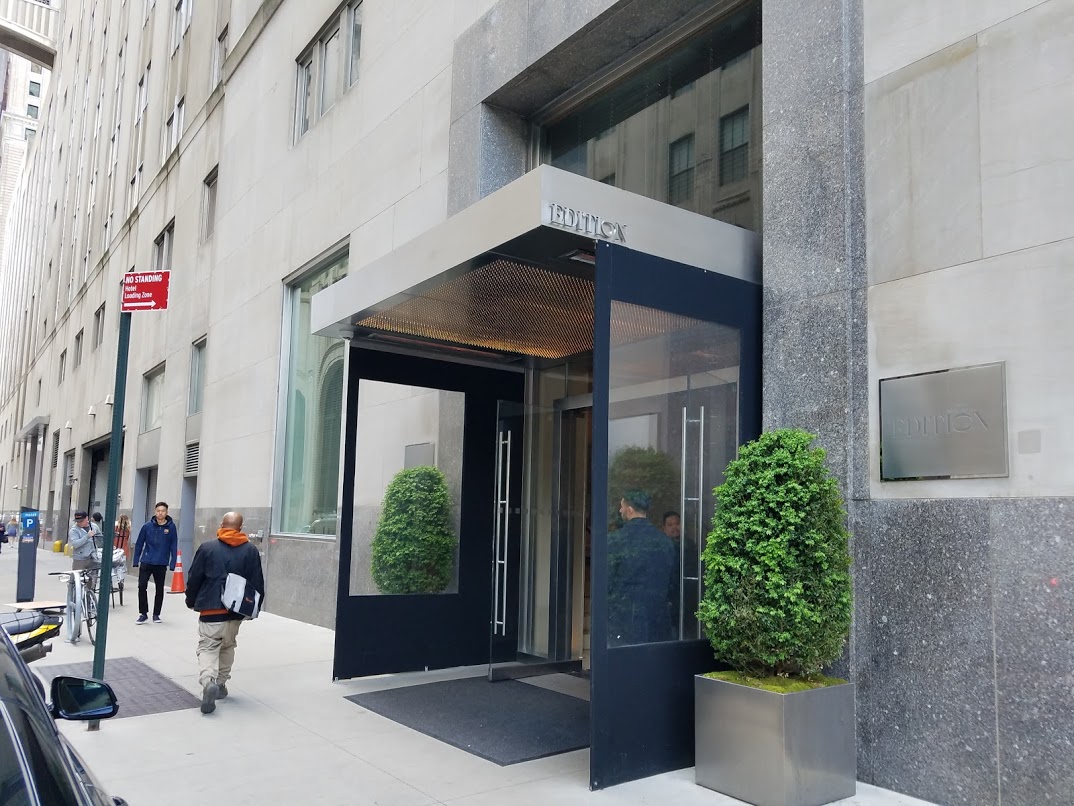Marriott’s peak and off peak award pricing is now live. This brings Marriott close to being a revenue-based program.
Marriott will be updating peak and off peak dates around once per month. They aren’t setting dates for the year and leaving them alone. That way hotels that are selling out on a given date, where Marriott would have to reimburse a property more for an award, can be moved to peak and require more points.
Here’s the new award chart.

Marriott tells me though that “it may take a few hours to fully update our servers” so there may still be hotels not yet showing peak pricing. And it’s still possible to book awards at those properties as they roll out the changes. I’m not saying to go look for a needle in a haystack, but some glitches and delays in raising prices are likely out there.
When You’re Most Likely to Find Off-Peak Award Prices
The number of points you pay for a room has no bearing on the amount the hotel gets paid for your stay. Peak and off-peak pricing is about controlling Marriott Bonvoy’s costs. It’s (for the most part) not the hotel that’s deciding when you get charged more points. It’s Marriott corporate.
So the way to understand peak and off peak is that you’ll expect peak pricing when hotels are generally going to be full, because Marriott pays a premium to hotels for award guests when a property is fully booked.
There are times of year that hotels are much emptier, or at least the risk of their filling up is low and so Marriott isn’t going to see higher costs from redemptions as a result of occupancy. We can expect they’ll assign off-peak redemption prices to at least some of those dates.
Marriott shared a list of major destinations and dates when “Off-Peak rates will be most widely available” of course each night can have a different award price, and those prices can change monthly.
- Hawaii: October through mid-December (2019) and late September through October (2020) depending on market
- California Wine Country: Mid-November (2019) through April (2020)
- New York: January through February (2020)
- Orlando: beginning in May with the greatest concentration in August and September (2020)
- Washington DC: Late November (2019) through February (2020)
- Capetown: May through August (2020)
- Dubai: May through September (2020)
- European destinations primary November (2019) through March (2020)
- Maldives: May through June and end of August through early October (2020)
- Bora Bora: January through March (2020)
- Bali: November through mid-December (2019), mid-January through March (2020)
- Phuket: May through June (2020)
- Koh Samui: October through mid-December (2019) and September through October (2020)
- Costa Rica: October (2019) and August through October (2020)
- Macau: March through June (2020)

Westin Phuket
Trust me that many of these are places you don’t want to go to when they’re likely off-peak. I have much enjoyed my time in the U.A.E. but really don’t want to visit Dubai in July. New York is cold in January. The Maldives can be really rainy in May and June. You may luck out, but you may not be able to go out in the water or dive for days.
Hopefully these date ranges aren’t exhaustive, because while DC’s winter months aren’t a good time to visit even if they’re off peak, August too (not listed above) is dead while Congress is in recess and the city built on a swamp is sticky as can be.
Hawaii is often nice even when it’s not a peak travel date, such as when school is in session, but I’m sad to see that we should expect fewer off peak periods there in 2020 than we’ll see this year.
All that said, Bali can be lovely in March and I happen to enjoy the major European capitals more in Winter when they aren’t packed full of American teenagers.

St. Regis Bali
Re-pricing Awards You Already Have Booked
If you have a standard room redemption made at regular price and it’s available at off-peak pricing now, you’ll need to cancel and rebook to get the lower price (and cancellation rules of your reservation apply). Since there’s no published list of peak and off-peak dates, and those dates will change, it’s not a matter of ‘getting an existing reservation re-priced’.
That also means if you book a regular or peak award night you can keep checking in case it shifts downward in price after booking.
Change to How 5th Night Free Prices Work
Instead of receiving “fifth night free” on an award stay, since the price of some reward nights in your booking may vary with peak and off peak, they’re going to give you the least expensive night of your 5 night stay free.
Taking off the average would be more reasonable. This is a cost cutting measure and ensures that you don’t get a ‘windfall’ by timing your stay so that the 5th night is in peak while you pay for off peak nights.
They call this “Stay for 5, Pay for 4” and it replaces “5th Night Free.”

New York Edition
If You Want Classic Award Chart Value, Look to Hyatt
The great thing in the past with award categories (thankfully still offered by Hyatt) is that there was a single redemption price for the year and you could get great value for your points when rates were high. High season pricing limits the ability to do that, limits your upside with the program.
Hilton no longer has this. IHG pulled award charts, too. And Marriott still publishes a chart but with prices that vary monthly.


It’s friggin’ gross. NYC, fall Oct 26: courtyards, residence, fairfield, springhill – 40,000-50,000, Ritz – 100,000.
Not understanding the peak pricing here. The peak rates are only certain dates during a particular month and don’t actually correlate to the prices on that date…for example some of the cheapest cash rate days are pricing as peak and not the most expensive dates.
“Trust me that many of these are places you don’t want to go to when they’re likely off-peak.” Too true.
Gary – correct me if I’m wrong, but I think the thought going into this was that Marriott would set x dates per property (of course higher for higher demand ones) as peak, maybe some saver, and that is that.
What your post seems to indicate is that EVEN if a property is first set as “standard” (legacy pricing), if it starts filling up, it could move to PEAK virtually at any time? Do you have verification of this?
This is one step closer to variable pricing, and IMO was “not in the cards” to to speak when peak/off-peak was introduced. Your initial discovery of the ratio being across the company, and NOT just at the property level, was already a thumb in the eye by Marriott.
(BTW – even more glad I have shifted most of my business over to Hyatt)
To follow up – Marriott Lurker just confirmed this on FT. What a joke of a company. Basically variable pricing by day now. For shame.
Did a quick search in Paris. Obviously peak rates in summer. However, it’s standard rate in the winter and not low.
Yup, they have Bonvoyed us once again.
Courtyard Siem Reap when I booked it (2 nights), 25,000 points or $285.72. Now, 30,000 points or $261.71. Points price up, cash price down.
Sheraton Grand Danang (3 nights), 105,000 points or $756.78. Now, 115,000 points or $707.28. Points price up, cash price down.
@UA-NYC Gary mentions that “Marriott will be updating peak and off peak dates around once per month.” Other sites have also reported it being “adjusted monthly” (The Points Guy). I’m not 100% clear whether it’s “around” once per month or truly one set time per month (e.g. the first of every month), but the latter is the impression I was under.
So while a particular date can definitely move from standard to peak (or off-peak to standard, or maybe even off-peak to peak – or the other way around, too), if that interpretation is right, it wouldn’t be virtually at any time, but just one set time per month. At least, I hope that’s how it’s done, so it’s at least predictable when it’s able to change.
@kabukijuul I’ve noticed this too. It’s strange; apparently it’s based on anticipated demand rather than cash rate? (Even though in theory, cash rates should also be based on anticipated demand?) I’ve read that it’s based on an algorithm; have to wonder what the algorithm bases it on.
I can’t complain TOO much though. Just now, I was able to book a hotel that’s category 1 *and* a PointSavers property, for 25 nights, during a mostly off-peak period in January (19 off-peak and 6 standard nights), for a total of 92,000 points. (4,000 points * [19 off-peak nights – 5 free nights due to “stay for 5, pay for 4”] + 6,000 points * 6 standard nights.) It’s just a basic Fairfield Inn (though it’s got a pool and hot tub), but the more important thing to me is getting that Platinum status back. 25 nights + 15 credit card nights + 10 nights for hosting a “meeting” = 50 nights = Platinum status for 92k points + <$200. Who says you can't "buy back" Platinum status anymore? 😉 (And that's for over 2 full years of it, too – January 2020 through February 2022 – likely staying enough in 2020 to make it Titanium.)
From a sample I did I am seriously thinking the Marriott card and it’s annual award night is no longer worth keeping. A half dozen properties I might have been interested in went up enough to be unavailable for award night use.
Given these changes, I’ll be transferring my Marriott points into airline miles, before they obliterate that program feature.
I have checking hotels in Britain for November, which should be low season. Sure enough, the point totals did go down (off-peak) from yesterday.
But all for naught, because the cash rates are so low then that even with fewer points needed, the best redemption I could find is still at less than 0.5cpp.
Looking like all downside with the new award pricing.
Chase and Amex need to convert their annual free night certs to Category (5 or 6, depending upon the card) and not number of points, or people will be dropping their cards like hot potatoes.
@UA-NYC yes i have verification of this. The property doesn’t set which dates are peak/off peak, and Marriott will be making changes to what hotels and dates are peak/off peak each month.
RIP SPG
“checking hotels in Britain for November, which should be low season. Sure enough, the point totals did go down (off-peak) from yesterday.
But all for naught, because the cash rates are so low then that even with fewer points needed, the best redemption I could find is still at less than 0.5cpp.”
Wait, JohnnyBoy, are you seriously complaining that the points redemption price went down AND the cash price is too low? I get that that the cpp is poor, but did you really prefer the November rates prior to the price reduction? Would you be happier if they increased the cash price so your cpp was better?
@Lexy, I think JohnnyBoy’s point was more that using points wasn’t a good value before *or* after the change when cash rates are low (i.e. no improvement; always better to use cash), whereas it now represents a worse value than before when cash rates are high (still better than using cash, but fewer cpp).
Before:
• Cash rates low: points no good, use cash
• Cash rates medium: points are decent
• Cash rates high: points are good
After:
• Cash rates low / off-peak awards: points typically still no good, use cash
• Cash rates medium / standard awards: points are decent
• Cash rates high / peak awards: points are still only decent unless cash rate is exorbitantly high
So in the new system, points are almost never a good deal now. Marriott justifies the higher peak rates by emphasizing that they’re balanced by lower off-peak rates, but the lower off-peak rates arguably add little or no value to the program since using cash is still almost always better, while the higher peak rates significantly take away value – not really “balanced.”
My counter-argument to that would be, check out lower-category hotels. To me, that’s where the real redemption value lies. A category 1 hotel off-peak for 5,000 points a night (4,000 for PointSavers) when the cash rate could be upwards of $100/night? That’s 2 cpp normally, or 2.5 cpp for PointSavers. Add in “stay for 5, pay for 4” and we’re talking 4,000 points a night (or 3,200 for PointSavers) for stays that are a multiple of 5 nights. $500 / 20,000pts = 2.5 cpp. ($500 / 16,000pts = 3.125 cpp for PointSavers.) I managed to book such an award stay Saturday (cat 1 PointSavers, multiple of 5 nights, mostly off-peak) for almost 3.6 cpp – so, it’s not all bad!
^To add to that, I guess my other counterargument is that as noted earlier, peak/off-peak award pricing (for some reason) doesn’t always correlate with how high or low the cash rates are. There can be peak award nights with lower cash rates than some standard or off-peak nights at a given property – and vice versa. So if you happen to find a night that’s labeled off-peak despite cash rates being high, it can still net you a good deal. (Of course, in a perfect world, at a fixed level of points, lower cash rates would always be preferred, just as for a given cash price level, lower point cost would be preferred.)
Makes you think hard about the current air miles for Bonvoy point promo currently running.